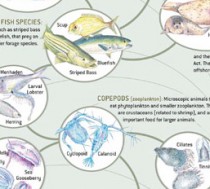Fish Take Mercury Up the Food Chain

Fishing is a fun activity for the Sound’s anglers, with a bonus that they can bring home a healthy, high protein food. But some fish can contain toxic contaminants such as mercury that is harmful to both fish and humans. Large fish can particularly be exposed to high levels of mercury through a process call Biomagnification or Bioaccumulation, which is why health departments issue advisories to limit consumption of some fish.
From the smokestacks of power plants to the discharges from wastewater treatment plants, and other places, mercury in the form of the compound methylmercury exists in the enviroment, and it can settle to the seafloor and be taken up by tiny organisms that live or feed on bottom sediments.
From there mercury or other toxic contaminants that settle on the seafloor poses a threat to the ecosystem. According to NOAA’s Ocean Explorer website:
… these compounds aren’t digested, they accumulate within the animals that ingest them, and become more and more concentrated as they pass along the food chain as animals eat and then are eaten in turn. This is biomagnification, and it means that higher-level predators-fish, birds, and marine mammals-build up greater and more dangerous amounts of toxic materials than animals lower on the food chain.
Human exposure to methylmercury occurs mostly from consuming fish and shellfish and “almost all people have at least small amounts of methylmercury in their bodies, reflecting the widespread presence of methylmercury in the environment,” according to EPA’s Health Effects of Exposures to Mercury. For most people, blood mercury levels are below levels associated with possible health effects, but the EPA website includes this warning: “Methylmercury … is a powerful neurotoxin, and people exposed to high levels may experience adverse health effects. If you are concerned about your exposure to methylmercury, you should consult your physician.”
Facts about Mercury and Long Island Sound
- With the decline in industry around Long Island Sound and tighter regulations, concentrations of mercury in Long Island Sound have declined, but are still higher than the pre-industrial period of the 19th century. (source: https://longislandsoundstudy.net/wp-content/uploads/2017/11/heavy-metals-in-sediment.pdf)
- Mercury deposited in marshes can be harmful to the reproduction of tidal marsh songbirds, according to new research conducted by a team of scientists in the Northeast who belong to the Saltmarsh Habitat and Avian Research Program. Read an abstract from the scientific journal, Ecotoxicology.
- In the 2000s the Long Island Sound Study Research Grant program provided grants for research on mercury and other toxic contaminants. Information on these research projects are in the Long Island Sound Research Grant Program web pages:
- Chemical Residues in Fish and Lobster in Long Island Sound: A Bi-State Update (see description in 2008 research grant page)
- Environmental Change in Long Island Sound over the Last 400 Years (see description in 2000 research grant page)
The Mad Hatter Mercury Mystery
In 2002, Peg Van Patten, who was then the Communications Director for Connecticut Sea Grant, profiled Dr. Johan “Joop” Varekamp in Wrack Lines magazine on his research connecting mercury contamination in the Sound with an industrial city’s hat making past. Varekamp, who was then a professor in the Earth and Environmental Sciences Department at Wesleyan University, was able to trace through sediment core samples that the source of mercury deposits found in the Housatonic River at the mouth of Long Island Sound was from Danbury, a city located off the banks of the Still River, an upstream tributary of the Housatonic. In the 19th century and 20th centuries Danbury was known as the Hat City where fur hats were manufactured using mercury to toughen the fur hat fibers. Varekamp also wrote about the legacy contaminant in the fall 2012 issue of Long Island Sound Study’s Sound Update newsletter (see page 3).
